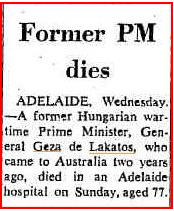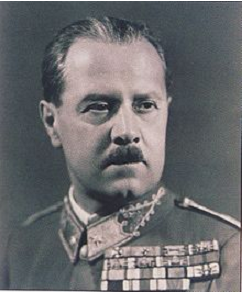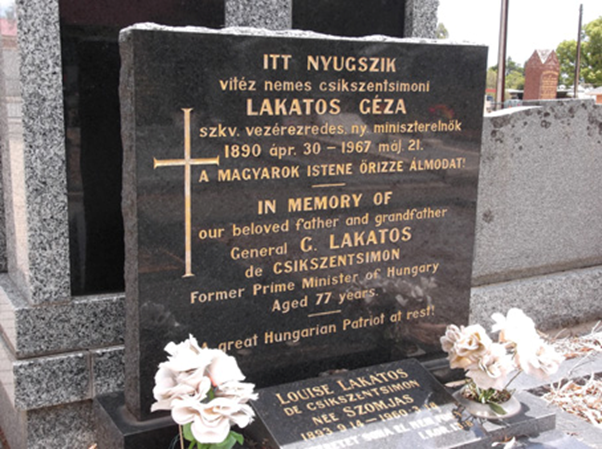Lakatos, Geza
Hungarian Statesman buried at Athelstone
 This is the only indication, in Australia, of the death of Geza Lakatos, and was printed in the Canberra Times in 1967.1
This is the only indication, in Australia, of the death of Geza Lakatos, and was printed in the Canberra Times in 1967.1
Geza Lakatos was born in Budapest in 1890. At 20 years of age, he graduated as a second lieutenant from the Ludovika Military Academy in Budapest. He served as an infantry officer, for the Austro-Hungarian Army, throughout its Empire. In 1914 he was accepted into the War Academy in Vienna.2 His studies were interrupted by WW1, and he was sent to the Russian front as a staff officer to a Brigadier. In 1917 he was transferred to the Italian front. At the end of the war, the allies split up the Austro-Hungarian Empire, and relocated its European boundaries. Overnight Hungary lost 2/3rds of its land mass and 1/3rd of its Hungarian speaking population. The army was disbanded. It was during this time that a Bolshevik-Communist Revolution took control of the country. Home grown communists under Béla Kun formed The Hungarian Soviet Republic, which lasted for 133 days.3 This Government collapsed, when the Romanian Army occupied Hungary.
During this time Geza Lakatos was in charge of the military headquarters in Gődőllő. Politically he joined the Nationalists.4 Anti communist politicians decided to form a new Government after the failed communist coup. They were forming a military force known as the National Army, when the Romanian army invaded Budapest. The brief period of communist rule was known as the “Red Terror”. Due to the extreme violence used. When they were overthrown the period was known as the “White Terror” when the violence was reversed. After WW1 the allies would not allow the Austro-Hungarian monarch to return. The new Nationalist Government elected Admiral Horthy, a national hero, as the new Regent. The attempted revolution had a marked affect on the new and successive Governments. They feared Russia.
 Photo left of Geza Lakatos circa 1940 (photographer unknown) copied from Wikipedia under GNU free documentation licence.
Photo left of Geza Lakatos circa 1940 (photographer unknown) copied from Wikipedia under GNU free documentation licence.
In 1925 Geza Lakatos was made military attaché to Prague. He was also given the title of Vitez. (valiant or gallant soldier). In 1939 he was made a three star General. In 1943 he was the Chief of Defence Staff out of Kiev, and made a four star General in that year.5 Again because of the fear of Russia, Hungary aligned with Germany and fought against Russia. Germany installed a pro Nazi Government in Budapest to carry out its instructions and protect its self. When the Nazi aligned members of Government began to deport large numbers of the Jewish population Admiral Horthy intervened. Having been told they were being sent to labour camps as slave labour, the truth began to filter back that they were being exterminated. With one tank Geza Lakatos overthrew Döme Sztójay and those others sympathetic to Germany.6 Geza Lakatos then formed, and headed, as Prime Minister, a Government not aligned to the Nazis. The deportations were ordered to stop, and the law enforcers were advised to use deadly force to end them. The Government was now in a precarious position. The Russian army was almost on their doorstep, and the Nazis were incensed at the loss of an aligned partner in Hungary. Geza Lakatos began negotiations with the enemies of Germany, assuring them Hungary would surrender.7 He even tried to negotiate with Russia. When it became clear to Germany that Admiral Horthy was no longer a supporter, they captured his son and held him prisoner. Admiral Horthy was advised to undo his armistice with Russia or his son would be executed.8 Admiral Horthy had already lost a son in a flying accident during the war. He did as requested and Hitler’s answer was to invade and occupy Hungary. All Hungary’s anti Nazi politicians were arrested and imprisoned. On January 2nd 1945 Geza Lakatos was imprisoned by the Germans. He was released at the end of the war, only to be re-arrested and imprisoned by the Russians. In 1946 he was again released from prison. In 1949 the then Hungarian Government cancelled his pension and confiscated his property. To earn an income he returned to Budapest and began to illustrate books and hand paint silk scarves. Talents he had used many years before. In 1957 his daughter immigrated to Adelaide. He published his memoir in 1981. Titled “As I Saw It The tragedy of Hungary” It was released in West Germany and in the U.S.A. After the collapse of communism in 1992 it was released in Hungary. In 1965 he arrived in Adelaide to be with his daughter. He was the last constitutional Prime Minister in Hungary. He was replaced with a Nazi puppet, which in turn, was replaced by a Russian puppet. In 1967 on the 24th of May he died in Adelaide.9 He was buried at the Athelstone Independent cemetery, in Schulze Court.
 The grave of Geza Lakatos Photo by Jim Nelson taken 8/12/2015
The grave of Geza Lakatos Photo by Jim Nelson taken 8/12/2015
Researched and written by Jim Nelson, volunteer with the Campbelltown Library “Digital Diggers” group.
If you have any comments or questions regarding the information in this local history article, please contact the Local History officer on 8366 9357 or hthiselton@campbelltown.sa.gov.au
References
- The Canberra Times (ACT : 1926 - 1995)Thursday 25 May 1967 p 13
- http://immigrationplace.com.au/story/geza-lakatos/
- http://immigrationplace.com.au/story/geza-lakatos/
- http://immigrationplace.com.au/story/geza-lakatos/
- http://www.generals.dk/general/Lakatos/G%C3%A9za/Hungary.html
- http://immigrationplace.com.au/story/geza-lakatos/
- http://immigrationplace.com.au/story/geza-lakatos/
- https://en.wikipedia.org/wiki/Hungary_in_World_War_II
- http://immigrationplace.com.au/story/geza-lakatos/
Image of Geza Lakatos - See page for author [Public domain], https://commons.wikimedia.org/wiki/File%3ALakatosG%C3%A9za_Portrait_1940s.jpg via Wikimedia Commons
